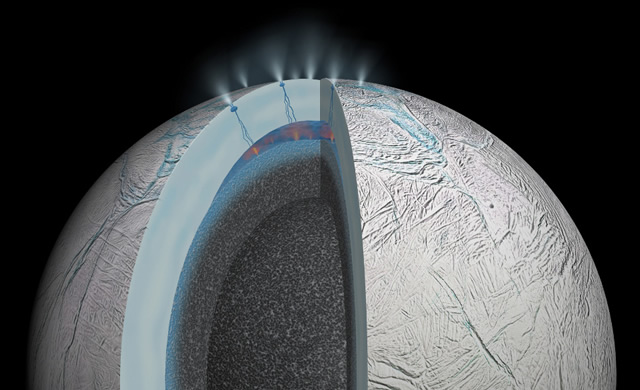
NASA: “Le zone del nostro sistema solare in cui si verificano ambienti estremi e in cui la vita potrebbe esistere, ci avvicinano a rispondere alla domanda: siamo soli nell’universo.”
All’interno di Encelado è possibile la vita? L’analisi chimico-fisica dei grani di polvere emessi dai geyser presenti nell’emisfero australe del satellite, catturati dalla sonda Cassini nello spazio interplanetario, suggeriscono che sia in corso attività di tipo idrotermale, come negli oceani terrestri. Lo studio su Nature.
Non è Saturnia, ma poco ci manca. Leggenda narra che la toponomastica della celebre località termale prenda le mosse da una feroce battaglia mitologica: i fulmini di Giove, mancando Saturno, avrebbero dato origine alle calde acque sulfuree del grossetano. Vero o falso che sia, a quanto si legge sull’ultimo numero di Nature qualche saetta potrebbe, in realtà, aver centrato il bersaglio – o quasi. È infatti nel sottosuolo di una delle lune di Saturno, quella palla di ghiaccio da circa 500 km di diametro chiamata Encelado, che per la prima volta sono stati individuati segnali d’attività idrotermale in atto in un corpo del Sistema solare che non sia la Terra. Detto altrimenti: acqua riscaldata da energia geotermica, proprio come avviene nelle sorgenti termali delle nostre dorsali oceaniche. Ambiente d’elezione – queste ultime – per microrganismi estremofili.
Fonte/Leggi tutto → Media.INAF.
Hydrothermal Activity on Saturn’s Moon Enceladus May Mean Life – NASA’s Cassini spacecraft has provided scientists the first clear evidence that Saturn’s moon Enceladus exhibits signs of present-day hydrothermal activity which may resemble that seen in the deep oceans on Earth. The implications of such activity on a world other than our planet open up unprecedented scientific possibilities. “These findings add to the possibility that Enceladus, which contains a subsurface ocean and displays remarkable geologic activity, could contain environments suitable for living organisms,” said John Grunsfeld, astronaut and associate administrator of NASA’s Science Mission Directorate in Washington.
“The locations in our solar system where extreme environments occur in which life might exist may bring us closer to answering the question: are we alone in the universe.”
Hydrothermal activity occurs when seawater infiltrates and reacts with a rocky crust and emerges as a heated, mineral-laden solution, a natural occurrence in Earth’s oceans. According to two science papers, the results are the first clear indications an icy moon may have similar ongoing active processes. The first paper, published this week in the journal Nature, relates to microscopic grains of rock detected by Cassini in the Saturn system. An extensive, four-year analysis of data from the spacecraft, computer simulations and laboratory experiments led researchers to the conclusion the tiny grains most likely form when hot water containing dissolved minerals from the moon’s rocky interior travels upward, coming into contact with cooler water. Temperatures required for the interactions that produce the tiny rock grains would be at least 194 degrees Fahrenheit (90 degrees Celsius). “It’s very exciting that we can use these tiny grains of rock, spewed into space by geysers, to tell us about conditions on – and beneath – the ocean floor of an icy moon,” said the paper’s lead author Sean Hsu, a postdoctoral researcher at the University of Colorado at Boulder.
Source/Continue reading → JPL.NASA.gov






















Pingback: Su Europa e su Encelado prove di attività che può sostenere la vita – Ocean Worlds’ in Our Solar System | DENEB Official ©